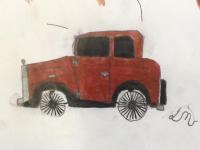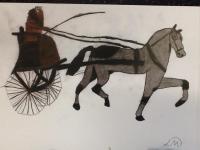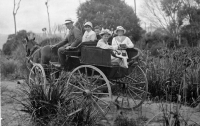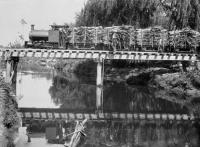Home-Shannon heritage
- History Of Shannon School
- Do You Remember the Time?
- Home Away from Home - Poutu Pa
- George Vance Shannon
- Edward Law 1864-1939
- Vogel Street
- Gunnings Go For It!
- Shannon Post Office
- Shannon Fire Station
- Shannon Railway Train Station
- Shannon Police Station
- A Mooing Hit and Miss
- The Shannon Bowling Club
- The Shannon Memorial Hall
- The Golden Days of Shannon Rugby
- Albion Tavern Shannon
- Club Hotel
- Renown Movie Cinema
- Mangahao Power to the People!
- Boxing - The Box Factory
- Flax Mills
- Our team
- Research process
- Learning outcomes
- References and acknowledgements
A Mooing Hit and Miss
Over the years there have been many changes in transportation. Our town Shannon has seen just a train, to horse and cart, to our modern day automobiles. Horses have been around for many years. Some of the Shannon residents used to ride horses to lots of different places, but then the British and the Americans thought of the idea of attaching a gig to a horse to tow people along. The wealthy Shannon residents used this to move people and supplies.
Before the Europeans arrived in Shannon, the Maori either walked or used water crafts along the Manawatu River. People had to use wooden carts before cars and trucks were invented. It would take a long time to travel. Horses and donkeys were often used to pull their carts. Children used to ride horses to school. In Shannon, the children would leave their horses in the paddock behind our Learning Action Centre (Library).
Here in Shannon there was a stable situated next to the theatre and it was here that visitors could hire a horse and gig on a ‘drive yourself’ system. Later, when the Mangahao Scheme started there were three to four motor taxis running as well as several motor buses.
The first airplane flown from Shannon was a homemade machine built by Len Mangham. It took off from the race course (REC) and, when trying to land, it hit a cow. Fortunately the machine and the pilot escaped injury.
Following the Second World War, there were many men who received resettlement farms in the Shannon District. This, along with the upgrading of the state highway through Shannon, brought a new-lease-of-life to the community.
John Loudon McAdam designed the first modern highways, using cheap paving material of soil and stone.
We interviewed Mr and Mrs McEwen. These are our questions followed by their response:
How did you get to school when you were young?
We rode ponies to school most days.
How did your parents get to work?
By push bike or they drove the truck out to the swamp.
How long have you lived in Shannon?
Seventy-eight years.
How did you get your groceries?
We walked or sometimes used a taxi.
How were the roads made?
Mainly gravel. There were not many tar sealed roads.
How did the roads feel when you drove on them?
Very rough. There were also tree stumps under the roads.
What was the most common transport?
Horse and cart and or your legs.
Were the vehicles hard to control?
A little bit. Mr McEwen said, “When I went to school there wasn’t much transportation, we mainly rode pushbikes.”
We also interviewed Mr Stuart Walker from PB Motors about his old car:
What type of car do you own?
An Austin and it is very slow.
When was your car made?
1936
How many people does it carry?
Five
How long have you owned your car?
One and a half years.
What type of engine is in your car?
Petrol, seven horsepower
Where was your car made?
England
Why did you buy this car? They don’t make these cars anymore and it would be a good challenge to fix it up
What are you going to do with your car?
I’m going to fix it up and drive it
Do you think this car was safe in its day?
Yes, super safe!
Was this car popular?
These cars have become very popular because they are now very rare.
Back in the old days there were three buses to school: one from Kingston Road, one from Mangaore and one from the Shannon Foxton Road. The railway was the most common way to travel as there were no roads until 1936. The roads were very bumpy and rough. The ferry went through the Manawatu River and it was the second most common way to travel. There were farm tracks connecting each farm. The railway ended in Longburn because the railway was private and the council didn’t want the railway to be connected to the Palmerston North railways.
Acknowledgements
Kete Horowhenua River and Rail - the story of Shannon, and Manawatu Memory Online .
Mr and Mrs McEwen Mr Walker, Mr and Mrs Law (The writers of the book From Bush and Swamp), and the Shannon Library.
Team effort by Rose (Year 8) and Liam (Year 8).








